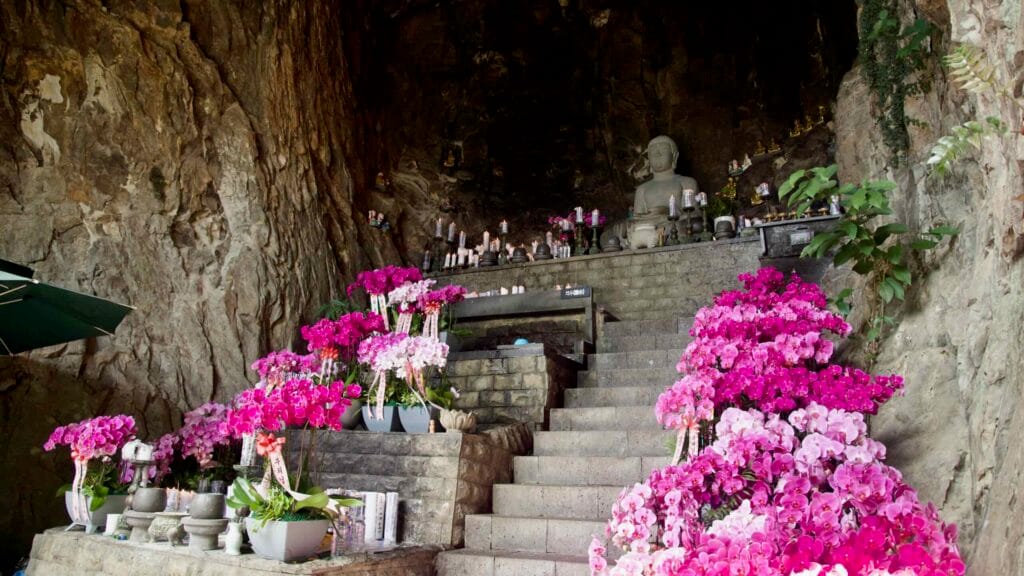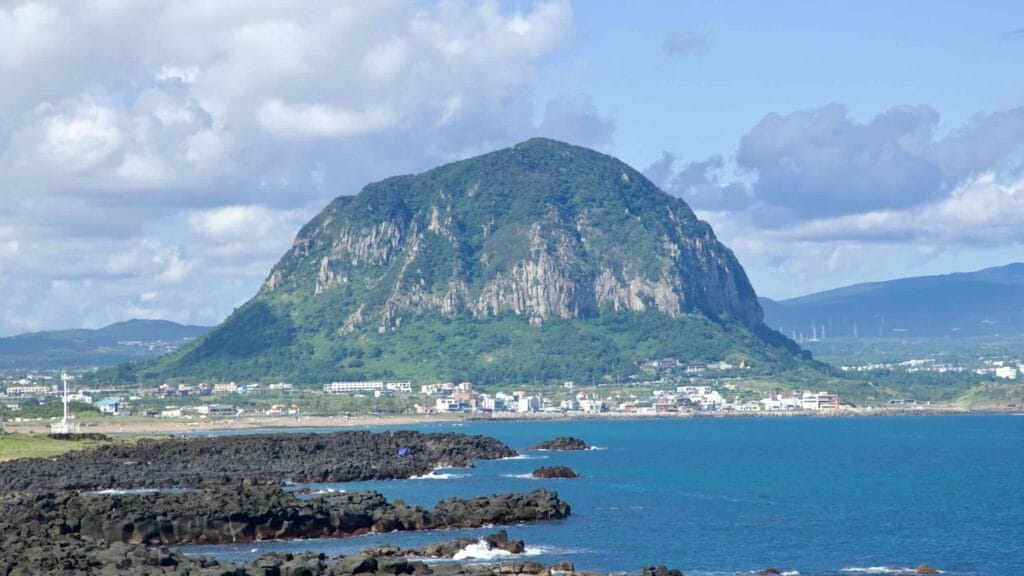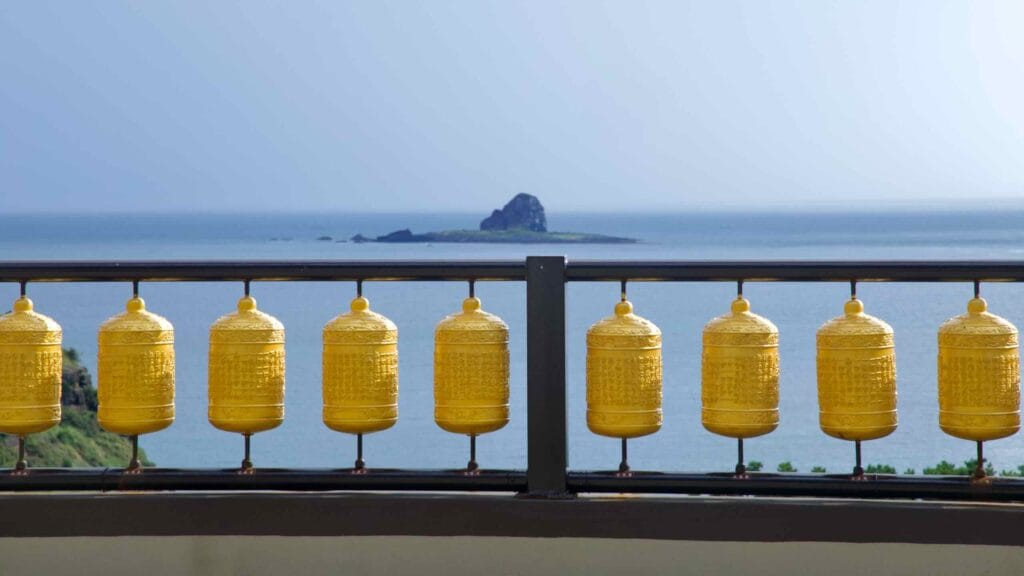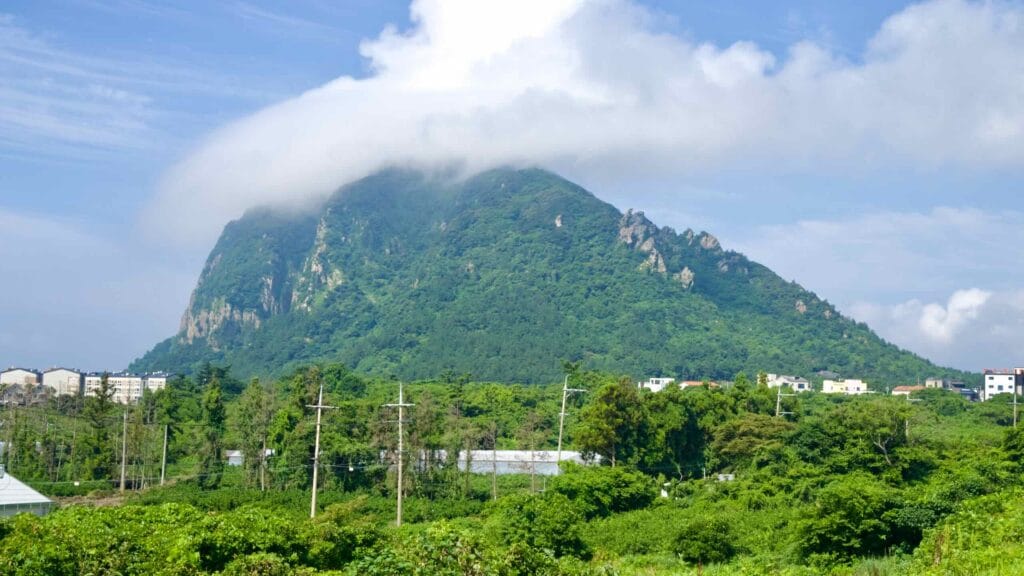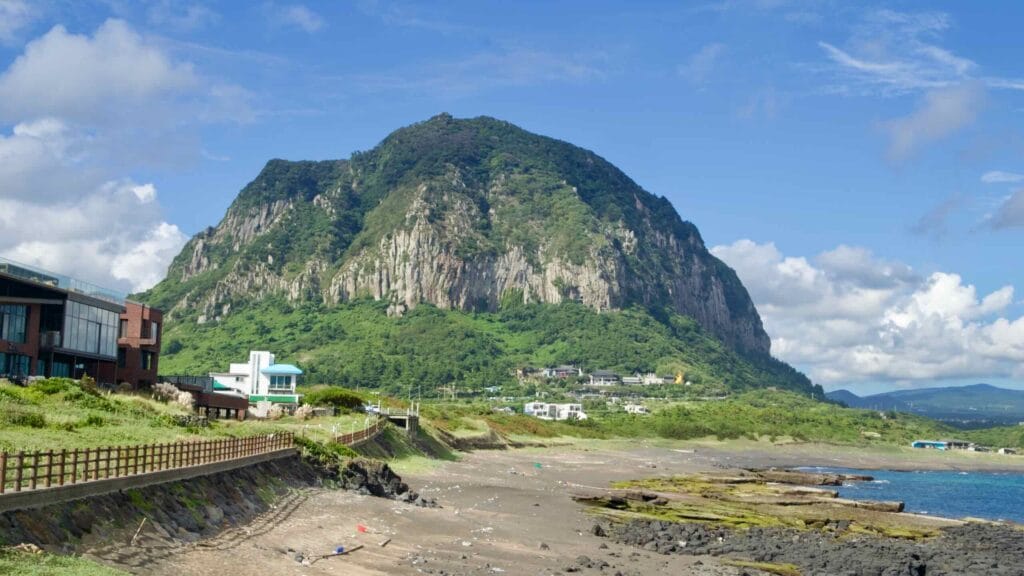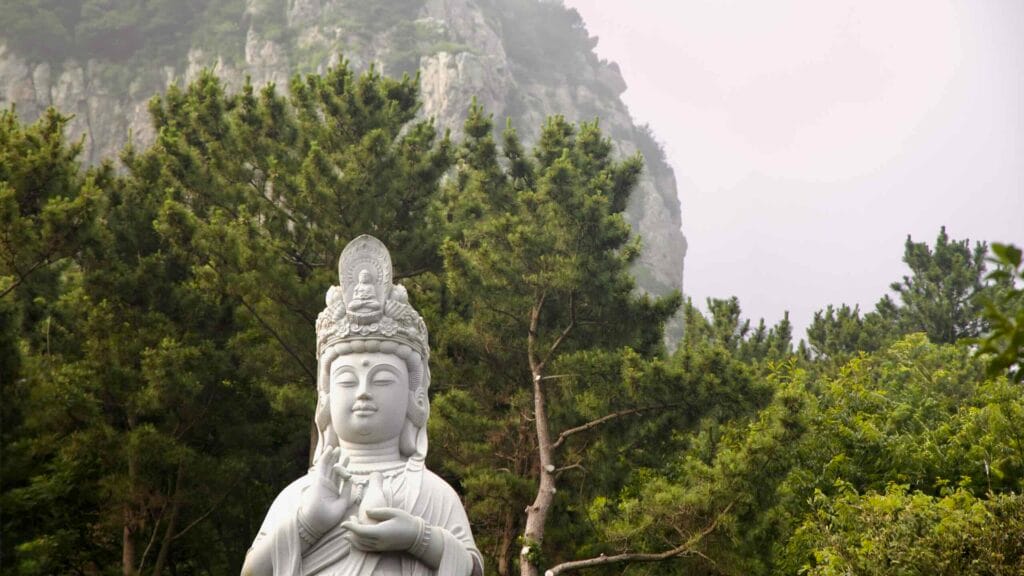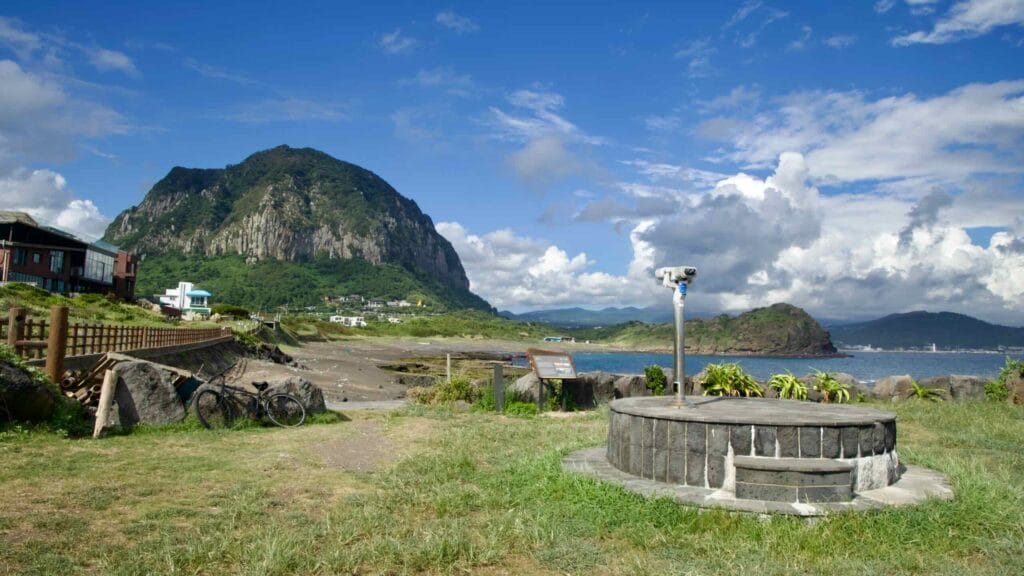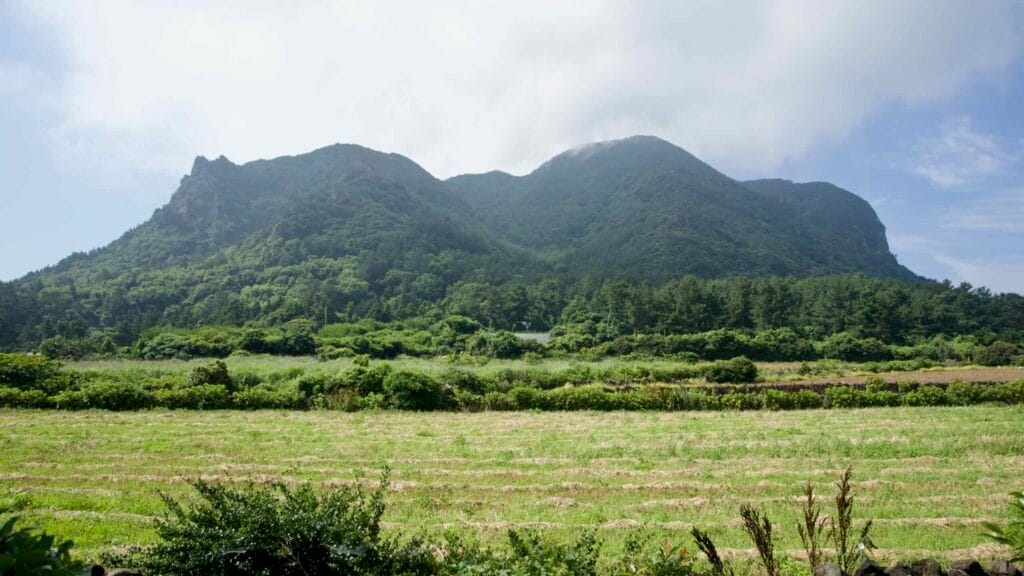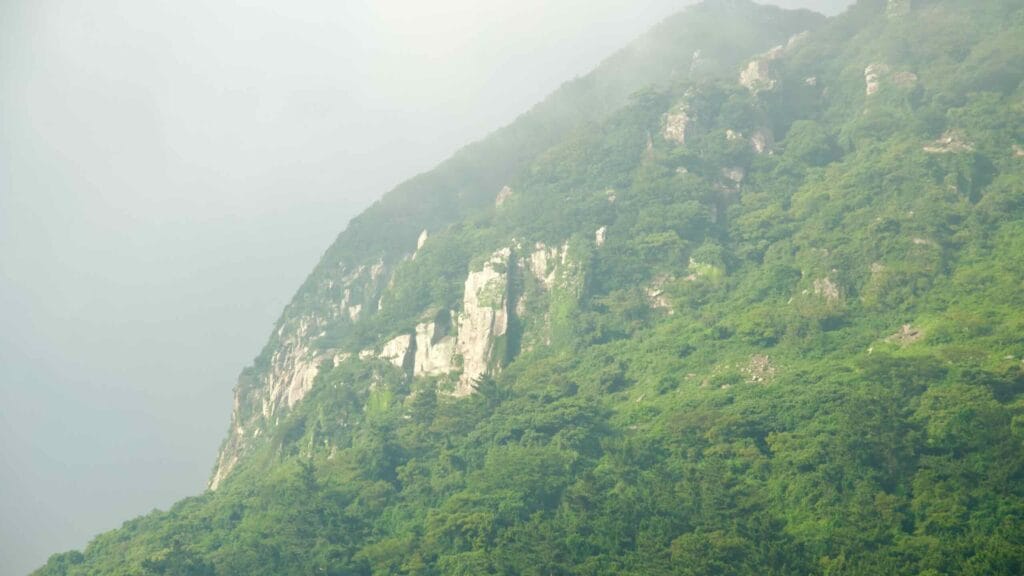Sanbang Mountain
Sanbang Mountain (산방산; map) or Sanbangsan is one of Jeju Island’s most striking natural landmarks, located along the southern coast in Seogwipo. Towering at 395 meters, this dome-shaped volcanic mountain stands out against the flat surrounding landscape.
Formed approximately 80,000 years ago during ancient volcanic activity, Sanbang Mountain is unique for its lack of a summit crater, distinguishing it from other volcanic formations on the island. Its geological and cultural significance has made it both a scientific marvel and a revered historical site.
The mountain’s name, meaning “mountain with a cave,” reflects its defining feature: Sanbanggulsa, a natural grotto that serves as both a spiritual and natural attraction.
Key Features
Let’s explore some of the mountain’s key features.
Sanbanggulsa Temple
Carved into the rugged slope of Sanban Mountain, the lava-dome mountain on Jeju’s southwest coast, Sanbanggulsa Temple (산방굴사; map)—literally “Mountain Cave Temple”—is a small, cave-set Buddhist shrine offering a blend of legend, nature, and quiet reverence.
The cave, about five meters tall, houses a seated statue of the Historical Buddha, said to date back to the Goryeo dynasty, with water droplets falling from the ceiling into small rock pools below—a mystical sight tied to local folklore.
A short but steep stairway leads up from the base past Bomunsa Temple. Along the ascent, there are viewing platforms—one called the Altar of Prayer for Life—where tradition tells visitors may find blessings for fertility or enduring love. At the summit, Sanbanggulsa offers sweeping views of the South Sea, including Marado Island and the dramatic Yongmeori Coast.
Bomunsa Temple
Nestled midway up Sanbangsan, Bomunsa Temple (보문사; map) serves as both a spiritual waypoint and a scenic highlight before reaching the famed Sanbanggulsa cave temple.
Bomunsa is believed to date back centuries—some legends suggest it was founded during the Silla era under Queen Seondeok. The temple’s steps guide you past a graceful Gwanseeum-bosal statue and a striking five-story stone pagoda featuring a Dharma wheel.
Inside the Daeung-jeon Hall, a triad altar features Seokgamoni-bul (the Historical Buddha) flanked by Jijang-bosal and another Gwanseeum-bosal, accented by hundreds of small white Buddha statues and a touching Gamno-do (Sweet Dew Mural) for departed ancestors.
Outside, a row of stone Nahan figures—representing the Buddha’s disciples—stand against the backdrop of the South Sea.
From Bomunsa’s terraces, visitors are treated to sweeping views toward the South Sea, the Yongmeori Coast, and even Marado Island—one of Jeju’s Ten Grand Views. This makes the temple not only a spiritual stop but a visual anchor in the landscape.
Geology
Sanbang Mountain stands out as one of Jeju Island’s most dramatic geological features—a trachytic lava dome rising approximately 395 meters above the southwest coast. This dome formed when high-viscosity magma slowly extruded from a volcanic vent, building a steep, bell-shaped ridge rather than explosively erupting. It is part of the island’s complex volcanic field and is recognized as a key highlight within the Jeju Global Geopark.
Petrographic studies confirm the dome is composed primarily of trachyte, not trachy-andesite as previously thought, with silica (SiO₂) content ranging between 59.75% and 63.46%.
Sandwiched against the sedimentary layers of the Yongmeori Coast, Sanbangsan exemplifies the geological interplay between volcanic and marine systems. Its conspicuous profile, rising above relatively flat terrain, frequently generates cap clouds that swirl around its summit.
Geologists classify Sanbangsan among Jeju’s major volcanic forms—part of a taxonomy that includes tuff cones, maars, and scoria cones—highlighting its scientific significance and its role in educational geotrails.
Views and Landmarks
From the vantage point of Sanbanggulsa Temple, visitors can view Jeju’s southern coastline. Key sights include Yongmeori Coast, a dramatic sandstone formation shaped by ocean erosion, and the islands of Gapa Island and Mara Island, visible in the distance.
The mountain is located near other attractions, such as the Hamel Exhibition Hall, which commemorates the 17th Century Dutch sailor Hendrick Hamel’s time on Jeju, and Songak Mountain, a dormant volcanic peak.
Legends and Folklore
Sanbang Mountain holds several legends offer with explanations for its origins:
- The Fallen Peak of Hallasan: One of the most enduring tales tells of a hunter who, while hunting on Hallasan, accidentally shot at the Jade Emperor’s rear. In fury, the Emperor ripped the peak off Hallasan and flung it toward the southwest coast—it landed as Sanbangsan, leaving behind Hallasan’s crater, Baengnokdam, in a perfectly matching void.
- Sanbangdeok’s Tears: The clear water that drips from Sanbanggul cave’s ceiling is said to be the tears of Sanbangdeok, a mountain goddess, weeping for the land she protects.
- Seolmundae Halmang’s Creation: In Jeju’s creation mythology, the giant goddess Seolmundae Halmang fashioned the island by gathering soil in her skirt. Finding Hallasan too sharp, she cut its top and flung it toward the sea—forming Sanbangsan.
Seasonal Highlights
Sanbang Mountain is a year-round destination, but its popularity peaks in spring when the surrounding fields burst into vivid yellow canola flowers. These blossoms blanket the landscape, creating a vivid contrast against the mountain’s gray cliffs. The picturesque scene draws photographers, artists, and nature enthusiasts.
Practical Information
Sanbangsan is easily accessible by bicycle, car, or bus, with well-marked routes leading to its base. A designated pathway provides access to Sanbanggulsa Temple, though the climb involves steep and rugged terrain.
- Wear comfortable walking shoes for safety and ease.
- Entry fees for Sanbanggulsa are modest, typically around 1,000 KRW.
The mountain’s central location also places it near other key attractions such as Yongmeori Coast, Songak Mountain, and the Sanbangsan Carbonate Hot Springs.
Culture and Environment
Sanbang Mountain holds dual designations as a natural monument (No. 376) and a scenic site (No. 77), underscoring its cultural and environmental importance. Conservation efforts aim to protect its delicate ecosystem and geological features. These include limiting access to certain areas, maintaining trails to minimize human impact, and preserving sacred sites such as Sanbanggulsa Temple.
Visitors are encouraged to follow all guidelines, respecting the environment and cultural landmarks to ensure this unique site remains pristine for future generations.




